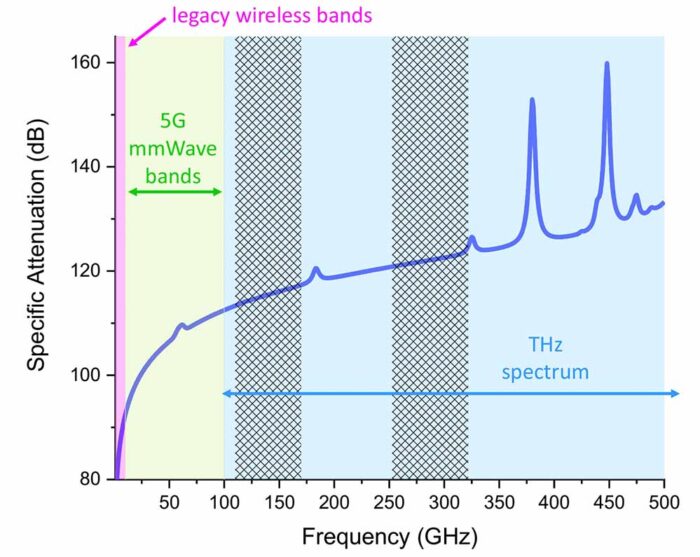Josep Jornet
Professor of Electrical and Computer Engineering

The attenuation of a propagating radio wave due to both free-space path loss and atmospheric absorption, for an assumed propagation distance of 100 m, at a temperature of 15 °C and relative humidity of 59%, using a standard atmospheric model (see [10, 11]). The shaded areas indicate the range of frequencies corresponding to legacy wireless systems, the 5G millimeter-wave range, and the THz spectrum. The hatched areas are the two bands of significant interest for communications mentioned in the text. Image and caption from nature.com
Wireless communication has been rapidly evolving over the past decades, providing us with the convenience and connectivity that has become an integral part of our daily lives. With the ongoing deployment of 5G networks, researchers are already envisioning the future of wireless systems beyond the current generation. To meet the ever-increasing demand for higher data rates and broader bandwidths, wireless platforms will need to venture into higher frequencies, beyond the familiar gigahertz range. This brings us to the realm of sub-terahertz wireless communications, an area of intense research and exploration.
Traditional wireless systems have mainly operated below a few gigahertz, but the surge in wireless traffic necessitates seeking new frequency bands with larger bandwidths. The millimeter-wave range, accessed by modern Wi-Fi and 5G technologies, offered a significant boost in data rates. However, the pursuit of even higher data rates has driven researchers to explore frequencies above 100 GHz, commonly known as the “terahertz (THz) range.”
Within the terahertz range, research has primarily focused on specific broad spectral bands, including the waveguide D band (110−170 GHz) and the higher frequency bands defined by IEEE 802.15.3d standards document (252−322 GHz). These frequencies are beyond the highest millimeter-wave bands found in current Wi-Fi and 5G standards. Operating at these ultra-high frequencies poses new challenges and opportunities that necessitate innovative solutions.
This Nature Communications article, explores within sub-terahertz wireless communications while presenting solutions and future possibilities that lie ahead for 5G and beyond.
The field of sub-terahertz wireless communications is advancing rapidly, with major research efforts ramping up around the globe. To address some of the significant hurdles associated with exploiting these high frequencies for broadband and secure networking, systems will require extensive new capabilities for sensing their environment and manipulating their broadcasts. Based on these requirements, a vision for future wireless systems is beginning to emerge. In this Perspective article, we discuss some of the prominent challenges and possible solutions which are at the forefront of current research, and which will contribute to the architecture of wireless platforms beyond 5G.
Source: nature.com
Read the full article here:
Professor of Electrical and Computer Engineering